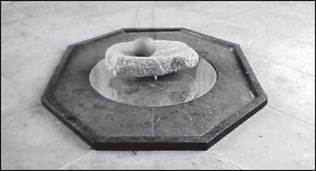About 4,000 years ago, with the mortar and pestle proving unsuitable for the finer grinding needed for new commodities, the saddlestone mill was invented. Saddlestones use a horizontal fixed stone, over which the moving stone travels in a back-and-forth motion. This mill, which again relied on human muscles as the source of energy, was used to finely grind various raw materials for more than 1,500 years. But working with this mill was exhausting, and grinding became a feared form of labor, hated so deeply that it had to be carried out by slaves, prisoners, and the most menial of servants.
You are now a slave. Turn the millstone, grind the flour, off with your veils, strip off your fine clothes. (Good News Bible 1976, Isaiah 47:2)
Millstones were essential to daily domestic life in biblical times, and the meaning of any reference to them in a story or parable was understood instantly:
When you lend a man something, you are not to take as security his millstones used for grinding his corn. This would take away the family’s means of preparing food to keep alive. (Good News Bible 1976, Deuteronomy 24:6)
Then a mighty angel picked up a boulder the size of a large millstone and threw it into the sea saying “this is how the great city of Babylon will be violently thrown down and will never be seen again” (Revelation 18:21); …but a woman threw a millstone down on his head and fractured his skull… (Judges 9:53); [and] …his stony heart is without fear, as unyielding and hard as a millstone (Job 41:24).
(Good News Bible 1976)
References to millstones continued in stories and legends until roller mills replaced millstones and the stones lost their mystique. For example, in “The Juniper Tree” in Grimm’s Fairy Tales, the cruel stepmother received her just desserts for ill-treating her stepchildren when “the bird let fall the millstone upon her head and crushed her to pieces” (Grimm Brothers 1993). The place of millstones in folklore will forever be assured:
St. Piran, the patron saint of Cornish tinners, according to folklore, sailed to Cornwall from Ireland on a millstone. It seems he offended one of the Irish kings who had him shackled to a millstone and thrown into the sea. Those watching were amazed to see him rise to the surface of the water sitting astride the millstone. [The story continues that St. Piran introduced tin extraction to Cornwall when he saw the white metal flowing from fissures in rocks that he was heating to cook his dinner.] (Jolliffe 2001)
|
|
Millstones were the principal tools used for size reduction until about 2500 bc, when the quern was invented. The quern’s rotary motion was much easier to maintain than the back-and-forth motion of saddlestones. Although it could not match the saddle — stone in making very fine particles, in time, the quern became widely used. Larger querns were developed that could be driven by animals, and, after the water wheel was invented, it was used to drive these larger querns. Although waterpower was the first renewable source of energy to be harnessed, 500 years would elapse before water wheels replaced muscles as the main source of energy for producing flour. Slaves, after all, were cheaper than machines and could solve processing problems as they arose.
The grinding of minerals lagged behind that of grain, because hard, abrasive pebbles tended to wear and break the expensive stones used in querns. For thousands of years, miners used chisels, hammers, picks, or levers as tools for freeing metallic and nonmetallic minerals embedded in rock formations. These tools were pounded into rocks to break them free from larger rock formations; the broken rock was pounded with smaller rocks or hammers; and the small pebbles were ground with the same hand tools used to grind grain. Fire was used to heat rock formations in the hope that they would crack as they cooled, although this was a costly use of fuel (particularly trees).
Although fireworks were the origin of explosives for breaking boulders and pebbles from rock masses, how and when fireworks were discovered is not known. They may have originated in China during the first millennium ad from peasants building fires on saltpeter rocks and finding that large volumes of gas were generated, carrying glowing particles into the sky. By 1250, saltpeter was being used for military purposes (Atlas Powder Company 1987), but it was 1627 before black powder, which is a saltpeter-charcoal-sulfur mixture, was used for breaking rocks in mines. Many mine owners hesitated to use it because of premature explosions, but the more adventurous owners used it successfully, leading to its widespread adoption. Black powder was the main explosive for mining until Alfred Nobel made dynamite around 1860. The dynamite era lasted 100 years until dynamite was replaced by the safer and more flexible ammonium nitrate-fuel oil (ANFO) mixture.
Drilling holes in rocks so that explosives could be placed where they would have the most effect proved to be one of the most intractable of all problems associated with breakage. Muscles provided the only power that could be used for many years before mechanical rock drills were invented. Starting in about 1860, drills began to be developed in parallel with explosives.
The size reduction of minerals changed about 1500 ad, when high demand for metals led to the development of water-driven stamp mills for grinding large volumes of pebbles into small particles. In stamp mills, the pebbles were shattered by impact from hammers, with iron protecting the wearing surfaces. Even though these mills were mechanically complex, they were unchallenged as fine-grinding machines for 400 years, particularly because they could grind pebbles quickly.

